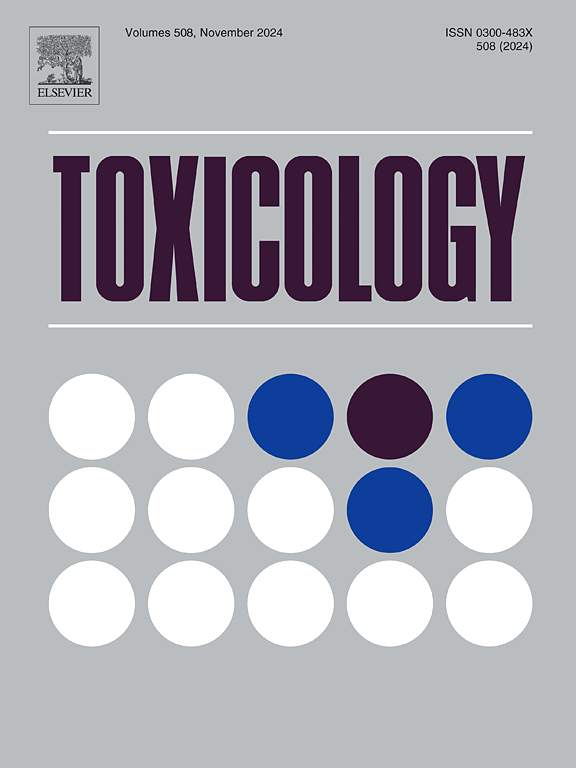烟草暴露介导的ELAVL1通过自噬激活调节膀胱癌细胞衰老。
IF 4.6
3区 医学
Q1 PHARMACOLOGY & PHARMACY
引用次数: 0
摘要
吸烟是膀胱癌的一个公认的危险因素,它与多种疾病的细胞衰老有关。然而,将吸烟暴露与膀胱癌衰老调节联系起来的调节机制仍然不完全明确。在本研究中,我们通过SA-β-gal染色、western blot和细胞恶性表型实验证明,吸烟致癌物4-氨基联苯(4-ABP)抑制细胞衰老,增强膀胱癌细胞的增殖、侵袭和迁移能力。基于CellAge数据库、南京膀胱癌数据库和公共数据库,进一步鉴定出275个膀胱癌特异性细胞衰老相关基因。通过580例膀胱癌病例和1101例对照的全基因组关联研究,我们发现ELAVL1中rs12978895 G>A与膀胱癌风险降低显著相关(优势比= 0.79,95%可信区间= 0.68-0.92),并与吸烟相互作用(P = 0.043)。在遗传调控方面,实验和群体研究均表明,rs12978895的A等位基因显著降低了ELAVL1的表达,而在肿瘤组织中,ELAVL1的表达水平升高。值得注意的是,暴露于吸烟致癌物4-ABP导致ELAVL1的表达显著增加,从而抑制膀胱癌细胞的衰老。机制上,4-ABP上调ELAVL1通过激活自噬抑制细胞衰老,从而促进膀胱癌的进展。本研究阐明了ELAVL1在烟草暴露细胞模型中的遗传易感性和生物学功能,为膀胱癌的病因学研究提供了新的线索。本文章由计算机程序翻译,如有差异,请以英文原文为准。
Tobacco smoking exposure-mediated ELAVL1 regulates bladder cancer cell senescence via autophagy activation
Tobacco smoking is a well-established risk factor for bladder cancer, which shows connection to cell senescence in various diseases. However, the regulatory mechanisms linking tobacco smoking exposure to senescence regulation in bladder cancer remain incompletely characterized. In this investigation, we demonstrated that the smoking carcinogen 4-aminobiphenyl (4-ABP) inhibited cell senescence while enhancing proliferative, invasive, and migratory capacities of bladder cancer cells, as evidenced by SA-β-gal staining, western blot and cell malignant phenotype experiments. We further identified 275 cell senescence-related genes specific to bladder cancer based on CellAge database, the Nanjing bladder cancer dataset and public database. Through genome-wide association studies in 580 bladder cancer cases and 1101 controls, we pinpointed that rs12978895 G>A in ELAVL1 was significantly correlated with decreased bladder cancer risk (odds ratio = 0.79, 95 % confidence interval = 0.68–0.92) and interacted with smoking (P = 0.043). In genetic regulation, both experimental and population study showed that the A allele of rs12978895 significantly reduced ELAVL1 expression, while elevated ELAVL1 levels were observed in tumor tissues. Notably, exposed to smoking carcinogen 4-ABP resulted in a markedly increased expression of ELAVL1, which inhibited senescence of bladder cancer cells. Mechanistically, 4-ABP upregulated ELAVL1 suppressed cell senescence through autophagy activation, thus promoting bladder cancer progression. This study elucidated the genetic susceptibility and biological function of ELAVL1 in tobacco smoking exposure cell models, shedding light on the etiology of bladder cancer.
求助全文
通过发布文献求助,成功后即可免费获取论文全文。
去求助
来源期刊

Toxicology
医学-毒理学
CiteScore
7.80
自引率
4.40%
发文量
222
审稿时长
23 days
期刊介绍:
Toxicology is an international, peer-reviewed journal that publishes only the highest quality original scientific research and critical reviews describing hypothesis-based investigations into mechanisms of toxicity associated with exposures to xenobiotic chemicals, particularly as it relates to human health. In this respect "mechanisms" is defined on both the macro (e.g. physiological, biological, kinetic, species, sex, etc.) and molecular (genomic, transcriptomic, metabolic, etc.) scale. Emphasis is placed on findings that identify novel hazards and that can be extrapolated to exposures and mechanisms that are relevant to estimating human risk. Toxicology also publishes brief communications, personal commentaries and opinion articles, as well as concise expert reviews on contemporary topics. All research and review articles published in Toxicology are subject to rigorous peer review. Authors are asked to contact the Editor-in-Chief prior to submitting review articles or commentaries for consideration for publication in Toxicology.
 求助内容:
求助内容: 应助结果提醒方式:
应助结果提醒方式:


